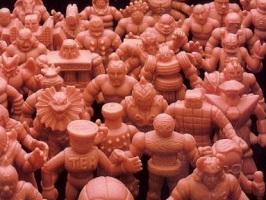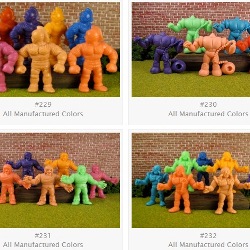UofMUSCLE.com – M.U.S.C.L.E. Figures from Mattel
Archeology 100 – The 2003 M.U.S.C.L.E. investigation
For many toy collectors, uncovering information about their favorite childhood toy is easy. They head to the library or search for information on a website. M.U.S.C.L.E. collectors did not have that luxury in 2003.
There were no books about M.U.S.C.L.E. and only a handful of websites, most of which did not factually delve into the history of M.U.S.C.L.E. The goal of this investigation was to substantiate collectors’ rumors, ideas, and fantasies. The plan was simple, contact and interview as many original sources as possible.
Stage 1 – Mattel
The first contact at Mattel was a woman in Consumer Relations, Valerie. She was not familiar with M.U.S.C.L.E. and was unable to answer any questions. In an effort to help Helene, the Director of Customer Service, was able to uncover a small, but important, piece of data. The figures had been produced by Bandai Japan and were only in the 1986 and 1987 catalogs.
During a phone call Helene said it would be difficult to uncover information because many of the employees that had worked at Mattel while M.U.S.C.L.E. was a product were no longer with Mattel. Senior leadership during M.U.S.C.L.E. would have retired and it would be almost impossible to know which subordinates had stayed with the organization and had any knowledge about M.U.S.C.L.E.
Mattel made a final effort to uncover information. Mattel’s Vice President of International Marketing, who regularly talked with Bandai, said:
In an effort to clarify the accessibility of the records, some follow-up questions were asked. Two things were made abundantly clear: (1) there was no one else even remotely interested or able to help research the topic of M.U.S.C.L.E.’s further; and (2) any records about M.U.S.C.L.E. had not survived the 20-plus years.
After months of phone calls and emails Mattel was unable to provide any additional information. Having uncovered that the figures had been produced by Bandai Japan, the next company contacted was Bandai.
Stage 2 – Bandai
Following an exchange of emails there was a telephone call with Bandai USA’s Marketing Director. She confirmed that Bandai Japan had manufactured the M.U.S.C.L.E. figures in both Japan and China. She also said it was possible, but unlikely, that the same factories are still in use. She went on to say that Mattel had simply released the toys in the United States. Bandai USA was responsible for releasing the toy in Latin America during the 1980’s.
Unable to provide any additional information she suggested two contacts. The first was a Product Supervisor responsible for Bandai’s Ultimate MUSCLE line. Due to a severe language barrier this proved a futile contact.
The second contact was a person with 4Kids Entertainment. They never returned any phone calls or emails.
Bandai Japan, the manufacturer of the figures, was the next organization contacted. For a variety of reasons it was decided that a written letter stood the best chance of receiving both a response and answers. Relatively quickly Bandai Japan’s Global Affairs contact responded. In broken English she stated that Bandai Japan no longer had any information about M.U.S.C.L.E. She apologized, and offered good luck in uncovering the desired information.
Stage 3 – Nestle
The last company contacted was Nestle. They had very little interest in helping to uncover any information. Their email response simply stated that they did not have any information regarding past promotions. Repeated inquires were met with similar responses.
Findings
This 2003 investigation uncovered five main pieces of information:
-
The years that M.U.S.C.L.E. was in the Mattel catalog.
-
Bandai Japan, not Mattel, had been the manufacturer of the figures.
-
Bandai had produced the figures in China and Japan in factories that were, likely, no longer in use.
-
Mattel simply distributed the figures.
-
The lack of M.U.S.C.L.E. records with Mattel, Bandai, and Nestle.
While these are interesting findings, uncovering quantifiable data looks to be nearly impossible. Qualitative data from former Mattel and Bandai employees could be the last remaining hope for fact-based M.U.S.C.L.E. data.
– Chad Perry (2003)


#1 by Jason Pratt on March 4, 2016 - 9:52 am
Hi – I come to this very, very late.
However, I am a big fan of MUSCLE.
I speak Japanese and live in Japan. If I can help you in translating any correspondence with the people you tried talking to before I’d be happy to help.
I know kind of the writer of kinniku man comics. In my previous job he and I had fun correspondence and he gave me a set of all of the kinkeshi (the one you can buy on the net) as a present. So to some extent I may be able to help open doors if there is a chance.